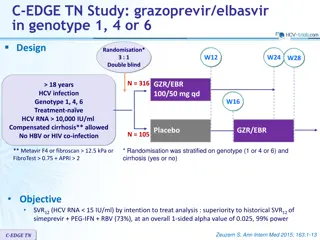
Good Relational Database Design Guidelines
Learn about the features of good relational design, decomposition techniques, lossy and lossless decomposition, and normalization theory in database systems. Understand how to avoid repetition of information, the importance of functional dependencies, and the process of creating lossless decompositions to maintain data integrity in databases.
Download Presentation

Please find below an Image/Link to download the presentation.
The content on the website is provided AS IS for your information and personal use only. It may not be sold, licensed, or shared on other websites without obtaining consent from the author. If you encounter any issues during the download, it is possible that the publisher has removed the file from their server.
You are allowed to download the files provided on this website for personal or commercial use, subject to the condition that they are used lawfully. All files are the property of their respective owners.
The content on the website is provided AS IS for your information and personal use only. It may not be sold, licensed, or shared on other websites without obtaining consent from the author.
E N D
Presentation Transcript
DATABASE SYTEMS UNIT V Dr.S.Chitra, Assistant Professor, Department of Computer Science, Annai Vailankanni Arts and Science College,Thanjavur
Outline Features of Good Relational Design Functional Dependencies Decomposition Using Functional Dependencies Normal Forms Functional Dependency Theory Algorithms for Decomposition using Functional Dependencies Decomposition Using Multivalued Dependencies More Normal Form Atomic Domains and First Normal Form Database-Design Process Modeling Temporal Data
Features of Good Relational Designs Suppose we combine instructor and department into in_dep, which represents the natural join on the relations instructor and department There is repetition of information Need to use null values (if we add a new department with no instructors)
Decomposition The only way to avoid the repetition-of-information problem in the in_dep schema is to decompose it into two schemas instructor and department schemas. Not all decompositions are good. Suppose we decompose employee(ID, name, street, city, salary) into employee1 (ID, name) employee2 (name, street, city, salary) The problem arises when we have two employees with the same name The next slide shows how we lose information -- we cannot reconstruct the original employee relation -- and so, this is a lossy decomposition.
Lossless Decomposition Let R be a relation schema and let R1 and R2 form a decomposition of R . That is R = R1 U R2 We say that the decomposition is a lossless decomposition if there is no loss of information by replacing R with the two relation schemas R1 U R2 Formally, R1 (r) R2 (r) = r And, conversely a decomposition is lossy if r R1 (r) R2 (r) = r
Example of Lossless Decomposition Decomposition of R = (A, B, C) R1 = (A, B) R2 = (B, C)
Normalization Theory Decide whether a particular relation R is in good form. In the case that a relation R is not in good form, decompose it into set of relations {R1, R2, ..., Rn} such that Each relation is in good form The decomposition is a lossless decomposition Our theory is based on: Functional dependencies Multivalued dependencies
Functional Dependencies There are usually a variety of constraints (rules) on the data in the real world. For example, some of the constraints that are expected to hold in a university database are: Students and instructors are uniquely identified by their ID. Each student and instructor has only one name. Each instructor and student is (primarily) associated with only one department. Each department has only one value for its budget, and only one associated building.
Functional Dependencies (Cont.) An instance of a relation that satisfies all such real-world constraints is called a legal instance of the relation; A legal instance of a database is one where all the relation instances are legal instances Constraints on the set of legal relations. Require that the value for a certain set of attributes determines uniquely the value for another set of attributes. A functional dependency is a generalization of the notion of a key.
Functional Dependencies Definition Let R be a relation schema R and R The functional dependency holds onR if and only if for any legal relations r(R), whenever any two tuples t1and t2 of r agree on the attributes , they also agree on the attributes . That is, t1[ ] = t2 [ ] t1[ ] = t2 [ ] Example: Consider r(A,B ) with the following instance of r. 1 1 5 3 7 4 On this instance, B A hold; A B does NOT hold,
Closure of a Set of Functional Dependencies Given a set F set of functional dependencies, there are certain other functional dependencies that are logically implied by F. If A B and B C, then we can infer that A C etc. The set of all functional dependencies logically implied by F is the closure of F. We denote the closure of F by F+.
Keys and Functional Dependencies K is a superkey for relation schema R if and only if K R K is a candidate key for R if and only if K R, and for no K, R Functional dependencies allow us to express constraints that cannot be expressed using superkeys. Consider the schema: in_dep (ID, name, salary, dept_name, building, budget ). We expect these functional dependencies to hold: dept_name building ID building but would not expect the following to hold: dept_name salary
Use of Functional Dependencies We use functional dependencies to: To test relations to see if they are legal under a given set of functional dependencies. If a relation r is legal under a set F of functional dependencies, we say that rsatisfies F. To specify constraints on the set of legal relations We say that Fholds onR if all legal relations on R satisfy the set of functional dependencies F. Note: A specific instance of a relation schema may satisfy a functional dependency even if the functional dependency does not hold on all legal instances. For example, a specific instance of instructor may, by chance, satisfy name ID.
Trivial Functional Dependencies A functional dependency is trivial if it is satisfied by all instances of a relation Example: ID, name ID name name In general, is trivial if
Lossless Decomposition We can use functional dependencies to show when certain decomposition are lossless. For the case of R = (R1, R2), we require that for all possible relations r on schema R r = R1(r ) R2(r ) A decomposition of R into R1 and R2 is lossless decomposition if at least one of the following dependencies is in F+: R1 R2 R1 R1 R2 R2 The above functional dependencies are a sufficient condition for lossless join decomposition; the dependencies are a necessary condition only if all constraints are functional dependencies
Example R = (A, B, C) F = {A B, B C) R1 = (A, B), R2 = (B, C) Lossless decomposition: R1 R2 = {B}and B BC R1 = (A, B), R2 = (A, C) Lossless decomposition: R1 R2 = {A}and A AB Note: B BC is a shorthand notation for B {B, C}
Dependency Preservation Testing functional dependency constraints each time the database is updated can be costly It is useful to design the database in a way that constraints can be tested efficiently. If testing a functional dependency can be done by considering just one relation, then the cost of testing this constraint is low When decomposing a relation it is possible that it is no longer possible to do the testing without having to perform a Cartesian Produced. A decomposition that makes it computationally hard to enforce functional dependency is said to be NOT dependency preserving.
Dependency Preservation Example dept_advisor(s_ID, i_ID, department_name) With function dependencies: i_ID dept_name s_ID, dept_name i_ID In the above design we are forced to repeat the department name once for each time an instructor participates in a dept_advisor relationship. To fix this, we need to decompose dept_advisor Any decomposition will not include all the attributes in s_ID, dept_name i_ID Thus, the composition NOT bedependency preserving Consider a schema:
Boyce-Codd Normal Form A relation schema R is in BCNF with respect to a set F of functional dependencies if for all functional dependencies in F+ of the form where R and R,at least one of the following holds: is trivial (i.e., ) is a superkey for R
Boyce-Codd Normal Form (Cont.) in_dep (ID, name, salary, dept_name, building, budget ) because : dept_name building, budget holds on in_dep but dept_name is not a superkey When decompose in_dept into instructor and department instructor is in BCNF department is in BCNF Example schema that is not in BCNF:
Decomposing a Schema into BCNF Let R be a schema R that is not in BCNF. Let be the FD that causes a violation of BCNF. We decompose R into: ( U ) ( R - ( - ) ) In our example of in_dep, = dept_name = building, budget and in_dep is replaced by ( U ) = ( dept_name, building, budget ) ( R - ( - ) ) = ( ID, name, dept_name, salary )
Example R = (A, B, C) F = {A B, B C) R1 = (A, B), R2 = (B, C) Lossless-join decomposition: Dependency preserving R1 = (A, B), R2 = (A, C) Lossless-join decomposition: Not dependency preserving (cannot check B C without computing R1 R1 R2 = {B}and B BC R1 R2 = {A}and A AB R2)
BCNF and Dependency Preservation dept_advisor(s_ID, i_ID, department_name) With function dependencies: i_ID dept_name s_ID, dept_name i_ID dept_advisor is not in BCNF i_ID is not a superkey. Any decomposition of dept_advisor will not include all the attributes in s_ID, dept_name i_ID Thus, the composition is NOT bedependency preserving It is not always possible to achieve both BCNF and dependency preservation Consider a schema:
Third Normal Form A relation schema R is in third normal form (3NF) if for all: in F+ at least one of the following holds: is trivial (i.e., ) is a superkey for R Each attribute A in is contained in a candidate key for R. (NOTE: each attribute may be in a different candidate key) If a relation is in BCNF it is in 3NF (since in BCNF one of the first two conditions above must hold). Third condition is a minimal relaxation of BCNF to ensure dependency preservation (will see why later).
3NF Example dept_advisor(s_ID, i_ID, dept_name) With function dependencies: i_ID dept_name s_ID, dept_name i_ID Two candidate keys = {s_ID, dept_name}, {s_ID, i_ID } We have seen before that dept_advisor is not in BCNF R, however, is in 3NF s_ID, dept_name is a superkey i_ID dept_nameand i_ID is NOT a superkey, but: { dept_name} {i_ID } = {dept_name } and dept_name is contained in a candidate key Consider a schema:
Redundancy in 3NF Consider the schema R below, which is in 3NF R = (J, K, L ) F = {JK L, L K } And an instance table: What is wrong with the table? where there is no corresponding value for J) Repetition of information Need to use null values (e.g., to represent the relationship l2, k2
Comparison of BCNF and 3NF Advantages to 3NF over BCNF. It is always possible to obtain a 3NF design without sacrificing losslessness or dependency preservation. Disadvantages to 3NF. We may have to use null values to represent some of the possible meaningful relationships among data items. There is the problem of repetition of information.
Goals of Normalization Let R be a relation scheme with a set F of functional dependencies. Decide whether a relation scheme R is in good form. In the case that a relation scheme R is not in good form, need to decompose it into a set of relation scheme {R1, R2, ..., Rn} such that: Each relation scheme is in good form The decomposition is a lossless decomposition Preferably, the decomposition should be dependency preserving.
How good is BCNF? There are database schemas in BCNF that do not seem to be sufficiently normalized Consider a relation inst_info (ID, child_name, phone) where an instructor may have more than one phone and can have multiple children Instance of inst_info
How good is BCNF? (Cont.) There are no non-trivial functional dependencies and therefore the relation is in BCNF Insertion anomalies i.e., if we add a phone 981-992-3443 to 99999, we need to add two tuples (99999, David, 981-992-3443) (99999, William, 981-992-3443)
Higher Normal Forms It is better to decompose inst_info into: inst_child: inst_phone: This suggests the need for higher normal forms, such as Fourth Normal Form (4NF), which we shall see later
Functional-Dependency Theory Roadmap consider the formal theory which functional dependencies are implied logically by a given set of functional dependencies. develop algorithms to generate lossless decompositions into BCNF and 3NF develop algorithms to test if a decomposition is dependency-preserving
Closure of a Set of Functional Dependencies Given a set F set of functional dependencies, there are certain other functional dependencies that are logically implied by F. If A B and B C, then we can infer that A C etc. The set of all functional dependencies logically implied by F is the closure of F. We denote the closure of F by F+.
Closure of a Set of Functional Dependencies We can compute F+, the closure of F, by repeatedly applying Armstrong s Axioms: Reflexive rule: if , then Augmentation rule: if , then Transitivity rule: if , and , then These rules are Sound -- generate only functional dependencies that actually hold, and Complete -- generate all functional dependencies that hold.
Example of F+ R = (A, B, C, G, H, I) F = { A B A C CG H CG I B H} Some members of F+ A H by transitivity from A B and B H AG I by augmenting A C with G, to get AG CG and then transitivity with CG I CG HI by augmenting CG I to infer CG CGI, and augmenting of CG H to infer CGI HI, and then transitivity
Closure of Functional Dependencies (Cont.) Additional rules: Union rule: If holds and holds, then holds. Decomposition rule:If holds, then holds and holds. Pseudotransitivity rule:If holds and holds, then holds. The above rules can be inferred from Armstrong s axioms.
Procedure for Computing F+ To compute the closure of a set of functional dependencies F: F + = F repeat for each functional dependency f in F+ apply reflexivity and augmentation rules on f add the resulting functional dependencies to F + for each pair of functional dependencies f1and f2 in F + iff1 and f2 can be combined using transitivity then add the resulting functional dependency to F + until F + does not change any further NOTE: We shall see an alternative procedure for this task later
Closure of Attribute Sets Given a set of attributes define the closureof underF (denoted by +) as the set of attributes that are functionally determined by under F Algorithm to compute +, the closure of under F result := ; while (changes to result) do for each in F do begin if result then result := result end
Example of Attribute Set Closure R = (A, B, C, G, H, I) F = {A B A C CG H CG I B H} (AG)+ 1. result = AG 2. result = ABCG (A C and A B) 3. result = ABCGH (CG H and CG AGBC) 4. result = ABCGHI (CG I and CG AGBCH) Is AG a candidate key? 1. Is AG a super key? 1. Does AG R? == Is R (AG)+ 2. Is any subset of AG a superkey? 1. Does A R? == Is R (A)+ 2. Does G R? == Is R (G)+ 3. In general: check for each subset of size n-1
Uses of Attribute Closure There are several uses of the attribute closure algorithm: Testing for superkey: To test if is a superkey, we compute +, and check if + contains all attributes of R. Testing functional dependencies To check if a functional dependency holds (or, in other words, is in F+), just check if +. That is, we compute + by using attribute closure, and then check if it contains . Is a simple and cheap test, and very useful Computing closure of F For each R, we find the closure +, and for each S +, we output a functional dependency S.
Canonical Cover Suppose that we have a set of functional dependencies F on a relation schema. Whenever a user performs an update on the relation, the database system must ensure that the update does not violate any functional dependencies; that is, all the functional dependencies in F are satisfied in the new database state. If an update violates any functional dependencies in the set F, the system must roll back the update. We can reduce the effort spent in checking for violations by testing a simplified set of functional dependencies that has the same closure as the given set. This simplified set is termed the canonical cover To define canonical cover we must first define extraneous attributes. An attribute of a functional dependency in F is extraneous if we can remove it without changing F +
Extraneous Attributes Removing an attribute from the left side of a functional dependency could make it a stronger constraint. For example, if we have AB C and remove B, we get the possibly stronger result A C. It may be stronger because A C logically implies AB C, but AB C does not, on its own, logically imply A C But, depending on what our set F of functional dependencies happens to be, we may be able to remove B from AB C safely. For example, suppose that F = {AB C, A D, D C} Then we can show that F logically implies A C, making extraneous in AB C.
Extraneous Attributes (Cont.) Removing an attribute from the right side of a functional dependency could make it a weaker constraint. For example, if we have AB CD and remove C, we get the possibly weaker result AB D. It may be weaker because using just AB D, we can no longer infer AB C. But, depending on what our set F of functional dependencies happens to be, we may be able to remove C from AB CD safely. For example, suppose that F = { AB CD, A C. Then we can show that even after replacing AB CD by AB D, we can still infer $AB C and thus AB CD.
Extraneous Attributes An attribute of a functional dependency in F is extraneous if we can remove it without changing F + Consider a set F of functional dependencies and the functional dependency in F. Remove from the left side: Attribute A is extraneous in if A and F logically implies (F { }) {( A) }. Remove from the right side: Attribute A is extraneous in if A and The set of functional dependencies (F { }) { ( A)} logically implies F. Note: implication in the opposite direction is trivial in each of the cases above, since a stronger functional dependency always implies a weaker one
Testing if an Attribute is Extraneous Let R be a relation schema and let F be a set of functional dependencies that hold on R . Consider an attribute in the functional dependency . To test if attribute A is extraneous in Consider the set: F' = (F { }) { ( A)}, check that + contains A; if it does, A is extraneous in To test if attribute A is extraneous in Let = {A}. Check if can be inferred from F. Compute + using the dependencies in F If + includes all attributes in then , A is extraneous in
Examples of Extraneous Attributes Let F = {AB CD, A E, E C } To check if C is extraneous in AB CD, we: Compute the attribute closure of AB under F' = {AB D,A E, E C} The closure is ABCDE, which includes CD This implies that C isextraneous
Canonical Cover A canonical coverfor F is a set of dependencies Fc such that F logically implies all dependencies in Fc , and Fclogically implies all dependencies in F, and No functional dependency in Fc contains an extraneous attribute, and Each left side of functional dependency in Fcis unique. That is, there are no two dependencies in Fc 1 1 and 2 2 such that 1 = 2
Canonical Cover To compute a canonical cover for F: repeat Use the union rule to replace any dependencies in F of the form 1 1 and 1 2 with 1 1 2 Find a functional dependency in Fc with an extraneous attribute either in or in /* Note: test for extraneous attributes done using Fc, not F*/ If an extraneous attribute is found, delete it from until (Fc not change Note: Union rule may become applicable after some extraneous attributes have been deleted, so it has to be re-applied
Example: Computing a Canonical Cover R = (A, B, C) F = {A BC B C A B AB C} Combine A BC and A B into A BC Set is now {A BC, B C, AB C} A is extraneous in AB C Check if the result of deleting A from AB C is implied by the other dependencies Yes: in fact, B C is already present! Set is now {A BC, B C} C is extraneous in A BC Check if A C is logically implied by A B and the other dependencies Yes: using transitivity on A B and B C. Can use attribute closure of A in more complex cases The canonical cover is: A B B C






















